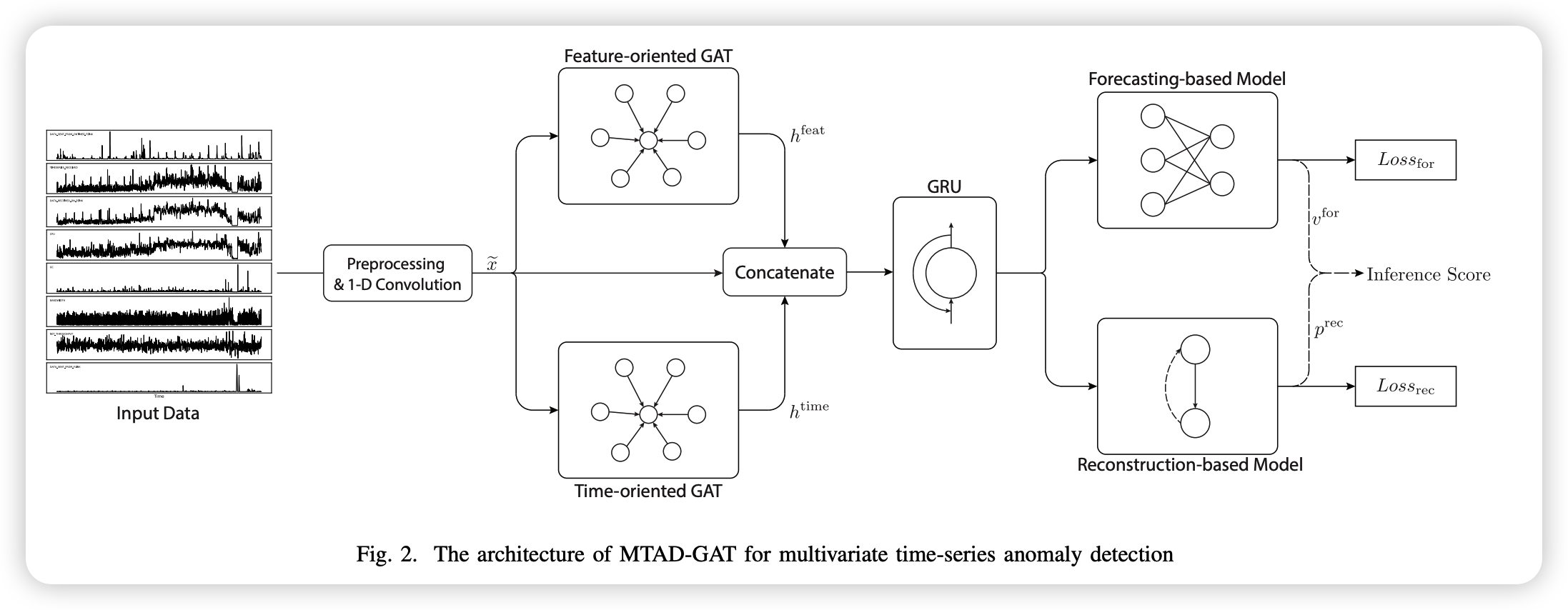Multivariate Time Series Anomaly Detection via Graph Attention Network (2020, 44)
Contents
- Abstract
- Introduction
- Related Works
- Methodology
- Overview
- Data preprocessing
- Graph Attention
- Joint Optimization
- Model Inference
0. Abstract
Anomaly detection on MTS
- recent approaches : do not capture relationships bewteen TSs
Propose a MULTI-variate TS Anomaly detection
- (1) considers each univariate TS as individual feature
- (2) includes 2 GAT layers in parallel
- a) for temporal dimensions
- b) for feature dimensions
- (3) jointly optimizes a
- a) forecasting-based model
- b) reconstruction-based model
1. Introduction
essential to consider CORRELATIONS between different TS
Propose MTAD-GAT ( = Multivariate Time-series Anomaly Detection via GAT )
-
(1) considers each univariate ts as individual feature
-
(2) tries to model the correlations between different features explicitly
2 GAT layers
- (1) feature-oriented
- capture causal relationshipbs between multiple features
- (2) time-oriented
- captures dependencies along the temporal dimension
2. Related Works
2 categories of Anomaly Detetion
- (1) individual TS by appyinig univariate models
- (2) multiple TS as a unified entity
2 paradigims of Anomaly Detetion
- (1) forecasting-based
- (2) reconstruction based
Both forecasting & reconstruction based models have supereiority in some situations
\(\rightarrow\) actually, they are complementary!
3. Methodology
Notation
-
\(x \in R^{n \times k}\) : input MTS
- \(n\) : maximum length of timestamps
- \(k\) : number of features
( for a long ts, generate fixed length inputs by a sliding window of length \(n\) )
-
\(y \in R^{n}\) : output vctor
- \(y_{i} \in\{0,1\}\) , whether anomaly or not
Address this problem, by modeling the inter-feature correlations & temporal dependencies,
-
with 2 GAT in parallel,
-
followed by GRU network
Leverage the power of both (1) forecasting & (2) reconstruction based models
(1) Overview
MTAD-GAT
-
step 1) apply 1-d convolution
- kernel size = 7
- extract high-level features
-
step 2) 2 parallel GAT layers
- captures relationshipbs between multiple features & timestamps
-
step 3) concatenate output & feed to GRU
- output 1) 1-d conv
-
output 2) two GAT layers
- feed the concatenated output to the GRU
- capture sequential patterns
-
step 4) feed into forecasting & reconstruction based models
- Forecasting based model : FC
- Reconstruction based model : VAE
(2) Data preprocessing
to improve robustness of the model!
- Data Normalization
- Data Cleaning
Data Normalization :
- Min-Max noramlization
- Data : both on Training & Testing set
Data Cleaning
-
sensitive to irregular & abnormal instances in training set
-
use SR (Spectral Residual) to detect anomaly timestamps in each individual TS
( threshold of 3 )
-
Data : only on Training set

(3) Graph Attention
- \(v_i\) : feature vector of each node
- output representation : \(h_{i}=\sigma\left(\sum_{j=1}^{L} \alpha_{i j} v_{j}\right)\).
Attention score ( \(\alpha_{ij}\) )
- \(e_{i j} =\operatorname{LeakyReLU}\left(w^{\top} \cdot\left(v_{i} \oplus v_{j}\right)\right)\).
- \(\alpha_{i j} =\frac{\exp \left(e_{i j}\right)}{\sum_{l=1}^{L} \exp \left(e_{i l}\right)}\).
(1) Feature Oriented GAT
- detect multivariate correlations
- structure
- node = ceratin feature ( \(x_{i}=\left\{x_{i, t} \mid t \in[0, n)\right\}\) )
- edge = relationship between two features
- output shape : \(k\times n\)
(2) Time Oriented GAT
- capture temporal dependencies in time-series
- consider all timestamps wihtin a sliding window as a complete graph
- structure
- node = feature vector at timestamp \(t\)
- adjacent nodes = all other timestamps in the current sliding window
- output shape : \(n\times k\)
Concatenate outputs
- a) feature-oriented GAT layer
- b) time-oriented GAT layer
- c) preprocessed \(\tilde{x}\)
\(\rightarrow\) matrix of shape \(n \times 3k\)
(4) Joint Optimization
Model
- (1) forecasting based model : predict the value at next timestamp
- (2) reconstruction based model : capture the data distn of entire time-series
Loss = \(Loss_{forecast} + Loss_{reconstruction}\)
(5) Model Inference
Two inference results for each timestamp
- result 1) prediction value \(\{ \hat{x_i} \mid i=1,\cdots k \}\)
- result 2) reconstruction probability \(\{ \hat{p_i} \mid i=1,\cdots k \}\)
Final inference score ( \(s_i\) )
-
balances their benefits, to maximize the overal effectiveness of AD
-
calculate \(s_i\) for each feature,
take summation of all features \(\rightarrow\) final score
-
anomaly if inference score is larger than a threshold
\(\text { score }=\sum_{i=1}^{k} s_{i}=\sum_{i=1}^{k} \frac{\left(\hat{x}_{i}-x_{i}\right)^{2}+\gamma \times\left(1-p_{i}\right)}{1+\gamma}\).
